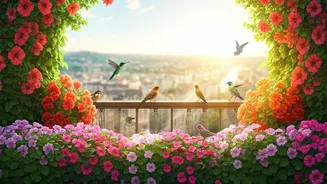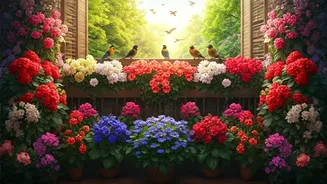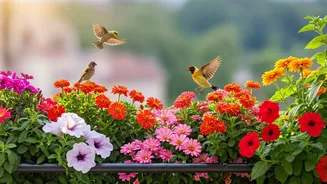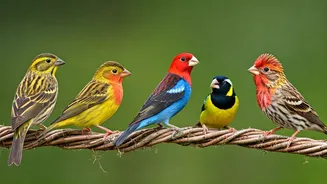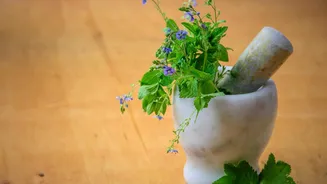Sunflowers: A Feast
Sunflowers are a fantastic choice, serving as a beacon for many avian visitors. These tall, cheerful blooms offer seeds that are a significant food source
for birds like finches and sparrows. Their height also offers shelter, making them an excellent choice for a balcony garden. To cultivate them successfully, ensure your balcony receives plenty of direct sunlight. Sunflowers thrive in well-draining soil and require regular watering, especially during the blooming season. The size of the flower head also helps to attract different bird species, and you can harvest the seeds after the bloom has faded, contributing to the cycle of life in your little balcony ecosystem. Consider planting different varieties to extend the availability of seeds throughout the season, which will also improve the chances of attracting a diverse range of birds. Planting these beautiful flowers on your balcony is a sure way to add some cheer to your everyday routine.
Marigolds: Pest Deterrent
Marigolds are not only visually appealing with their bright colors but are also a practical addition to your balcony garden. They have a natural ability to deter pests, which reduces the need for chemicals. This creates a safer environment for both the birds and your plants. Marigolds are relatively easy to grow, preferring sunny spots and well-drained soil. Regular deadheading, or removing the spent flower heads, encourages more blooms and extends the flowering season, which in turn offers a continuous supply of seeds and nectar. These blossoms draw in several bird species, including hummingbirds and finches, which are naturally attracted to their bright petals. When selecting marigold varieties for your balcony, choose shorter varieties to match the space and ensure they don’t outgrow their containers. Marigolds also work as a visual treat, providing bright accents that will boost your garden.
Petunias: Colorful Cascade
Petunias are famous for their cascading growth habit and vibrant colors, making them an excellent choice for hanging baskets and balcony containers. Their profuse flowering provides continuous nectar for hummingbirds and other nectar-feeding birds. Petunias prefer a sunny location, at least six hours of sunlight a day, and regular watering. Consistent deadheading also enhances blooming, making your balcony bright and busy with bird activity. They are a versatile addition to any balcony garden, offering a rainbow of colors to create a visually appealing space. To maximize the flowering and health of your petunias, use a balanced fertilizer every few weeks. This gives them the nutrients they need to produce vibrant blossoms and to stay healthy. Make sure that the planters have sufficient drainage to prevent waterlogging, which will prevent root rot and disease.
Zinnias: Butterfly Magnet
Zinnias are another brilliant choice, beloved for their bright, daisy-like flowers that bloom throughout the summer. These blooms attract butterflies, which, in turn, draws birds that feed on insects. Zinnias prefer full sun and well-drained soil; thus, make sure that your balcony receives plenty of sunlight. Regular watering and the removal of faded flowers encourage continual blooming. Zinnias come in various sizes and colors, which is a great way to add diversity to your balcony garden. To ensure your zinnias stay healthy, make sure the soil is rich in nutrients and that the plants have good air circulation. Zinnias are easy to grow from seeds, and they are excellent choices if you're looking for a colorful and productive addition to your balcony garden, offering vibrant blooms.
Nasturtiums: Edible Delight
Nasturtiums offer more than just beauty; their leaves and flowers are edible, adding a peppery flavor to salads and garnishes. These plants also attract hummingbirds and other pollinators, creating a busy and vibrant balcony ecosystem. Nasturtiums are very easy to grow, preferring full sun but tolerating partial shade. They are not very demanding in terms of soil, making them suitable for containers. Regular watering will encourage flower production. The vibrant color and the unique flavor of the plant make them an excellent addition to your balcony. Nasturtiums also help control pests because they can attract aphids, diverting them from other plants. This is a beneficial strategy to maintain plant health. Consider the climbing varieties, which will add a sense of movement and create visual interest in your balcony garden.
Lantana: Nectar Rich
Lantana is renowned for its vibrant, multi-colored flower clusters and its ability to attract butterflies and hummingbirds. These nectar-rich flowers provide a valuable food source, enriching the biodiversity of your balcony. Lantana thrives in full sun and well-drained soil, making it a good choice for sunny balconies. Regular pruning helps to maintain its shape and encourages more blooms. Lantana's ability to withstand high temperatures makes it a resilient plant. You can also bring it indoors during the colder months in regions with harsh winters. Choosing different varieties of lantana helps extend the blooming season, creating a sustained food source for your balcony birds. The plant is easy to grow and maintain, becoming a long-lasting addition to your balcony space. Proper drainage, along with a balanced fertilizer, promotes vibrant blooms.
Salvia: Hummingbird Favorite
Salvia is a magnet for hummingbirds, with its tubular flowers providing abundant nectar. Many varieties of Salvia offer striking colors and long blooming seasons. This plant flourishes in full sun and well-drained soil; therefore, it is perfect for balconies with plenty of sunlight. Regular watering and the removal of spent flower spikes promote continuous blooming, ensuring a steady supply of nectar for your avian visitors. The vibrant colors of salvia make it an attractive plant that will complement the other flowers in your balcony garden. This will provide a continuous source of food, making your balcony a haven for birds. The variety of salvias available provides a range of choices in color, size, and growing habit, which enables you to create a visually appealing garden.
Coneflowers: Seed Provider
Coneflowers, also known as Echinacea, are another great option, especially for attracting finches, who love the seeds these flowers produce. They feature distinctive, daisy-like flowers, which bring a touch of the countryside to your urban balcony. Coneflowers prefer full sun and well-drained soil; thus, make sure your balcony is a sunny spot. After flowering, leave the seed heads to dry on the plant. This will provide a natural food source for birds during the colder months. Coneflowers are relatively low-maintenance plants, which require minimal care once established, making them a good option for busy gardeners. They are also known for their medicinal properties. Choosing different coneflower varieties will add color and texture to your balcony, ensuring a balanced ecosystem for birds.
Lavender: Fragrant Charm
Lavender is not only known for its aromatic fragrance and beautiful purple flowers but also attracts bees, which indirectly supports bird life by providing a healthy ecosystem. Although it doesn't directly feed birds, its presence enhances the overall appeal of the balcony. Lavender needs full sun and well-drained soil; therefore, ensure that your balcony gets plenty of sunlight. Avoid overwatering to prevent root rot. This plant's ability to thrive in poor soil makes it easy to grow, and it can survive even in areas where other plants fail. You can also use lavender in potpourri and other homemade products. The aromatic properties of lavender can also help to repel certain pests, which protects your other plants. The addition of lavender is a great way to improve your balcony and make it bird-friendly.
Cosmos: Simple Beauty
Cosmos are a delightful choice, providing a simple yet elegant touch with their daisy-like blooms and attracting seed-eating birds. These easy-to-grow plants thrive in full sun and well-drained soil, making them suitable for most balconies. Regular deadheading extends the blooming season, ensuring a constant food source. Cosmos comes in several colors, offering a vibrant and lively display, which enhances the aesthetic appeal of your balcony. They are very easy to grow from seeds, and these plants can quickly fill your balcony with color and life. To further support bird activity, consider adding a bird bath or a small water source on your balcony to provide water for drinking and bathing, creating an ideal habitat for attracting and supporting your feathered friends.
